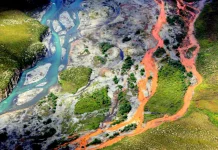Some exoplanets are tidally locked – like how only one side of the Moon ever faces the Earth – and we already know that planets like Mars and Earth experience a “polar wander,” causing heavier features to move toward equators. One French researcher thinks these combined behaviors could influence things like the atmosphere, chemistry, and climate of some distant planets. You probably think this is a totally made-up sci-fi setting, but a new paper suggests such a story could be quite possible.

Illustration: NASA Goddard Spaceflight Center
“When I learned about how the Earth’s spin axis moved over geological timescales, I wondered whether it should be the same for exoplanets,” Jérémy Leconte, researcher at the University of Bordeaux, told Gizmodo
Leconte’s research explores how tidally locked stars could experience true polar wander. Polar wander is best illustrated by one hypothesis about the largest mountain in the solar system, Olympus Mons on Mars: “It wasn’t created near the equator,” said Leconte. “The rotation axis shifted over millions of years to move this excessive mass towards the planet’s equator.” Earth, too, experiences polar wander.
Through mathematical analysis, Leconte found that these tidally locked planets should experience true polar wander. If that planet had, say, plate tectonics, the combined effects could cause a supercontinent to migrate to a place that always faces towards or away from the star. It could constantly shift, as mantle movements redistributed mass in the planet and changed the location of the poles. Not only that, his calculations also suggest the behavior could be more common and efficient on these exoplanets.
What would such a planet look like? Its greenhouse gases, temperature, and climate might vary from one half of the planet to the other. What if there was life on such a planet? How would it evolve?
“We make predictions, but it can take years before we know if it actually happens,” Leconte said.
Our solar system consists of eight planets we’re only just beginning to understand. But beyond our sun’s limits, there could be other, wild worlds with alien environments and behaviors beyond our comprehension. Isn’t that neat?












